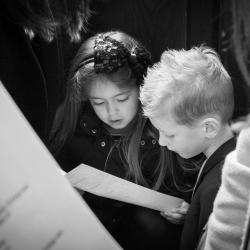In 1909 by Wolter te Riele (1867 - 1937). designed, in 1910-11 built neo-Gothic CROSS BASILICA, called H. Lambertus, with four-sided entrance tower and polygonal closed choir, with two ditto side chapels and baptismal chapel; adjoining each of the two transept arms a side chapel; belonging to the free-standing parsonage on the right. The tower, each provided with two elongated sound holes and a clock, is crowned by a low lantern with four corner turrets and an octagonal spire, which, like the roof turret, is covered with slates. The church, built of brick, contains pointed arch windows of various sizes with natural stone traceries and a stained glass filling, mostly with simple, geometric patterns, in the choir and transept partly with religious representations. The church is closed off by a combination of saddle, shield and lean-to roofs, covered with slates. The not completely symmetrically designed floor plan is centralising in design, with the side aisles increasing in width in leaps from the entrance and the choir flanked by two polygonal, less deeply extended side chapels; furthermore the hexagonal baptismal chapel and at the transept arms two straight-ended side chapels. The interior, executed in fair brickwork, which is plastered white around the windows and in the vault fields, is covered by net and star vaults at the wide, four-bay central nave and transept, by cross-ribbed vaults at the half-as-deep side aisles, and is divided into three aisles by round brick pillars with wide intercolumns; at the choir articulated pillars. The double-shell clerestory walls are provided with a triforium all around. The neo-Gothic interior also includes: the richly decorated altar, the wooden Marianum, the carved pulpit, supported by St. Lambertus, the painted Stations of the Cross, several colored statues of saints, as well as the confessionals. A church characteristic of the work of the late neo-Gothic architect te Riele, of centralizing design, with a striking tower and well-preserved interior, as such of importance because of its architectural-historical value.





